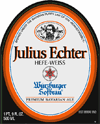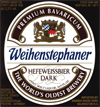Hefeweizen and Dunkelweizen
There is no denying the popularity of wheat beers these days, but they are as old as beer itself. Bavarian weizenbier, Berliner weisse, Belgian witbier, American wheat ales and lambic are all familiar wheat-based beers. Wheat even finds a supporting role in odd brews, adding complexity and lending its matchless ability to enhance head formation and retention. Summarily shunned or dismissed as an ingredient as being too crude, old fashioned, or simply too hard to deal with, wheat survives in beer and thrives today because of that same rusticity and uniqueness.
Ironically, the most popular of them all, the unfiltered hefeweizens (alternatively weissebier, weissbier, or weizenbier) of Bavaria are those that use wheat most prominently. They feature a top-fermenting yeasty footprint, a product of an extraordinary and complex strain that may be a bona fide remnant of early Germanic brewing. At different times, Bavarian hefeweizen has been archetypal, domestic, monastic, noble, proletarian and trivial. This brings us to its rediscovery just a few decades ago and a style that may indeed be the symbol of beer as we enjoy it into the future—one that allows us to appreciate the originals.
Grains of Civilization
The cultivation of grain and the domestication of animals allowed ancient tribes to abandon their nomadic lifestyle, settle together, develop farming techniques and other skills and exchange ideas. The very birth of civilization depended heavily on the ability to raise crops, grain being the most important. Barley and wheat cultivation comes from the Sumerians, some nine to ten millennia ago. Brewing followed shortly thereafter. The familiar (and speculative) tale is of sopping loaves of bread or grain, fermented with wild yeast, which led to the serendipitous discovery of a sourish beverage that produced a pleasant, exhilarating and invigorating buzz.
Brewing became a staple endeavor, a way to further use the grains that were being farmed. Actual depictions and written accounts of brewing and beer date to the third millennium BC in Mesopotamia.
Agriculture gradually moved out of the western Mediterranean and Mesopotamia and into the more temperate and less arid climate of central Europe. The cultivation of barley and wheat for food and beer was especially embraced by Germanic cultures at least 3000 years ago north of the Alps. These rough-hewn, hearty people of the forests and surrounding open land developed affinity for their homemade beer, to the point where much of their life revolved around it. Probably these were ales made with a mixture of barley, wheat and perhaps rye. In fact, a crock discovered in 1935 near Kulmbach contained the remnants of a black wheat beer dated to 800 BC. It is the oldest concrete evidence of brewing in Europe.
Wheaten Brewing
Wheat remained an essential ingredient in central Europe well into the first millennium, as brewing became relatively modernized by European monks, whose well-honed beer was considered the best. The monastic brewers of Germany and Bohemia recognized the extraordinary qualities of hops as early as the eighth century. Bavarian Benedictine monks of Weihenstephan described their hop gardens in documents at that time.
As secular brewing operations sprouted in Germany during the second millennium, many of them continued to brew wheat beers, which were often referred to as weissebier (white beer) because of their pale, cloudy appearance. They were distinctly different from their counterparts, sometimes made at the same brewery, known as rotbier (red beer), presumably the forerunners of dark lagers and altbier. The famous beers of Einbeck employed one-third wheat and relatively lightly-kilned barley, and they were considered the finest in all of Europe. They are also ancestral bock beers. Austrian and Dutch brewers were also adept at making wheat beers.
Though wheat beers may have been an ordinary quaff of the commoners throughout central Europe in the 1400s, this was not the case in the duchy of Bavaria. The noble Degenberger clan was the sole legal producer of weissebier. Other brewers would need their permission. When the Degenberger lineage passed, the licensing of wheat beer brewing was passed to the Bavarian house of dukes.
In an historic moment, the dukes Wilhelm IV and Ludwig X of the royal House of Wittlesbach introduced the Reinheitsgetbot Purity Law in 1516. The law stated that only barley malt, hops and water could be used to make beer. While on the surface the law appears to be a protective decree to preserve the quality of beer in Bavaria, the dukes had other motives. They controlled barley farming and wanted to ascertain their stake in this monopoly, but also, this ensured that the highly coveted weissbier would only be brewed under their direction, and mostly for their own consumption. This no doubt gave common brewers a push to perfect their barley beers (probably brown ales and lagers), but also separated wheat beers as a distinctly different entity.
This royal stranglehold lasted until the 1850s, when a weissebier brewery was commissioned to expert Munich brewer, Georg Schneider. He brewed first at the Weisse Hofbräuhaus, and later at Tal near the city’s main square. He then expanded into a second brewery in Kelheim in 1872, in the midst of the Hallertau hop growing area, as a private brewery. Weissebier was no longer under the royal thumb: it had gone mainstream.
This event coincided with the rise in popularity of Munich helles lagerbiers, but Schneider held on ever so tenuously to his market, and then saw a renewed interest in wheat beers following WWII. The popularity is keen, even 60 some years later.
Grain of Paradise
The now-popular hefeweizen needs little introduction to other than the most novice beer lover. The rebirth it has experienced, especially in the past 20 years, has ensured that nearly anyone interested in broadening their sense of beer appreciation has tried several.
Dunkelweizen is the dark version of hefeweizen, and is essentially identical except for the inclusion of some dark malt, and an attendant depth of flavor. In fact, dunkelweizen might even be more like the pre-Schnieder weizenbiers, as pale was a relative term up until the early 19th century. The flagship brew, Schnieder Weisse Original, continuously-brewed since 1872, has a rusty cast that is a window into the hefeweizens of several generations ago.
Most dunkelweizens will specify it on the label, just as it is assumed that a hefeweizen is a golden brew without stating it. The well-textured hefe and dunkel versions, brews that have not been stripped of their yeasty allure, are the authentic representatives of German beer in one of its most natural states.
By law, a German hefe or dunkelweizen must contain at least 50% malted wheat, but some may have as much as 70%. The remainder of the grist is, of course, barley malt. Hefeweizen would rely primarily on pilsner malt, while dunkelweizen might include Vienna, Munich or a caramunich variety for color, maltiness and complexity. Both are sparingly hopped, for bitterness only.
Fermentation is carried out with the inimitable Bavarian weizen yeast, one that sparks an aromatic and flavorful mix of vanilla, clove, bubblegum, banana or other spicy and fruity notes. The wheat itself lends a grainy, fresh bread character when combined with the yeast impression. Dunkelweizen would show off a bit of caramel and a light maltiness. The finish is tart, dryish and, owing to the chewy yeast and protein-rich wheat, paradoxically medium-bodied. All of this in a quenchingly modest strength of 5.0% ABV, give or take.
They are bottle-conditioned, either with the primary strain or a secondary lager strain to provide stability, and pour with a vigorous head. A proper half-litre weizen glass will corral their spirited personality. Many of the famous German breweries export them, as do some smaller ones, and they tend to travel well. American brewers are likely to replicate rather than Americanize them, and usually offer them as a seasonal. The dunkels are every bit as refreshing as the hefes.
The beer world may be more varied and exhilarating than ever, but there are some styles that never seem to entirely fade away, and are at some point enthusiastically embraced for their traditionalism or natural condition. Such are the weizenbiers of Bavaria. As the sultriness of summer arrives, they summon. Their refreshing, effervescent character is just the remedy for a lazy afternoon.

Julius Echter Hefe-Weiss
ABV: 4.9Tasting Notes: From the Würzburger Hofbräu in Würzburg, Germany, Julius Echter pours hazy gold with peach highlights. The aroma has lemon drop and vanilla, with a hint of fruit. Soft, fluffy mouthfeel, pleasantly tart, with notes of peach and banana in the flavor. Wonderfully quenching, slightly sour and phenolic finish. An outstanding summer beer, this would compliment a slice of lemon meringue pie perfectly.

Hacker-Pschorr Hefe Weisse Natürtrub
ABV: 5.5Tasting Notes: Brewed in Munich, Natürtrub (naturally sedimented) is pale orange in color and quite spicy up front. A clove, banana and citrus nose is backed up by a fresh white bread and yeasty aroma. Crisp and tart, with the familiar lemon-citrus flavor of wheat, clove character of the yeast and a dry grainy finish. Another outstanding offering from Hacker-Pschorr.

Georg Schneider and Sohn Schneider Weisse Original
ABV: 5.4Tasting Notes: As the name implies, this is Georg Schneider’s original beer and still the flagship. Tawny-colored and aromatic with nutmeg and cinnamon, apple and banana, with a hint of hops. More spicy banana in the flavor and a toasted malt backdrop, with a light hop bitterness. Very refreshing, dry and tart finish. It includes some Vienna malt in the grist. They also make a Weizen Hell, a golden hefeweizen introduced in 1994 as a nod to modern tastes, proving once again, that Schneider knows how to please.

Weihenstephaner Hefeweissbier Dunkel
ABV: 5.3Tasting Notes: From the oldest brewery in the world in Friesing, Germany, this dunkelweizen pours cloudy copper with a light beige, substantial and clingy head. The lace lasts the full glass. Nutmeg, banana and clove in the nose, with a spicy malt aroma. The faint malted-milk background hides behind a somewhat aggressive clove flavor, with subdued banana and raisin. Rather spritzy, with a dry, earthy finish and medium body. This classic blends the many flavors flawlessly.
K. Florian Klemp
K. Florian Klemp is an award-winning homebrewer and general hobbyist who thinks there is no more sublime marriage than that of art and science.

is there a difference between Julius Echter Hefe-weiss and Julius Echter hefe-weiss HELL? Thanks.
Hell means light. Think of the German Helles, blonde ales.
Where can I find some of these beers? I am particularly interested in buying some cases of Hacker-Pschorr Hefe Weisse Natürtrub or Weihenstephaner Hefeweissbier Dunkel
Any recipes for any of those beers would be nice to have!